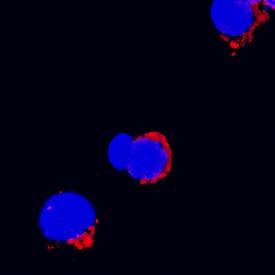Rat IL-3 Biotinylated Antibody Summary
Ile27-Cys169
Accession # NP_113701
Applications
Please Note: Optimal dilutions should be determined by each laboratory for each application. General Protocols are available in the Technical Information section on our website.
Scientific Data
 View Larger
View Larger
IL‑3 in Rat Splenocytes. IL-3 was detected in immersion fixed rat splenocytes using Goat Anti-Rat IL-3 Biotinylated Antigen Affinity-purified Polyclonal Antibody (Catalog # BAF2524) at 15 µg/mL for 3 hours at room temperature. Cells were stained using the NorthernLights™ 557-conjugated Streptavidin (red; Catalog # NL999) and counterstained with DAPI (blue). Specific staining was localized to cell surfaces. View our protocol for Fluorescent ICC Staining of Non-adherent Cells.
Preparation and Storage
- 12 months from date of receipt, -20 to -70 °C as supplied.
- 1 month, 2 to 8 °C under sterile conditions after reconstitution.
- 6 months, -20 to -70 °C under sterile conditions after reconstitution.
Background: IL-3
Rat interleukin-3 (IL-3; also multi-CSF) is a 26 kDa, variably glycosylated monomeric polypeptide that belongs to the alpha -helix family of hematopoietic cytokines (1, 2). IL-3 has pleiotrophic activies on a number of hematopoietic-related cells (1, 3). The rat molecule has two alternate splice forms. The first is termed IL-3 beta and is synthesized as a 169 amino acid (aa) precursor that contains a 27 aa signal sequence and a 142 aa mature segment (1, 2). The second is called IL-3 alpha, and is identical to IL-3 beta, save for a three amino acid (Tyr-Pro-Gln) deletion at positions 56-58 (1). The beta form is considered the most common form. Each form has an alpha -helical structure with two intrachain disulfide bonds and two potential N-linked glycosylation sites. Rat IL-3 is generally considered to be species-specific in its activity. In the mature region, rat IL-3 shares 55%, 30%, and 24% aa sequence identity with mouse, human, and bovine IL-3, respectively. Cells known to express IL-3 include connective tissue mast cells, astrocytes, microglia, megakaryocytes, eosinophils, T cells, keratinocytes and thymic epithelium.
IL-3 exerts its biological activities by binding to a 70 kDa, low affinity, ligand-binding IL-3 R alpha subunit, (6) which then recruits a 120 kDa, common beta -chain, signal transducing subunit (7) to form a functional IL-3 receptor (1, 6, 7). Receptors for IL-3 are present on bone marrow progenitors, macrophages, mast cells, eosinophils, megakaryocytes, basophils, and various myeloid leukemic cells. IL-3 can stimulate the proliferation and differentiation of pluripotent hematopoietic stem cells as well as various lineage committed progenitors including those for neutrophils, macrophages, magakaryocytes, and erythroid cells. IL-3 can stimulate the growth of early B cells and mature macrophages, mast cells, eosinophils, basophils, and megakaryocytes. IL-3 augments the function activity of basophils, mast cells, eosinophils, and macrophages (1, 8). In combination with other molecules such as CD40L and or IL-4, IL-3 can stimulate production of dendritic cells (1, 2, 9, 10).
- Martinez-Moczygemba, M. and D.P. Huston (2003) J. Allergy Clin. Immunol. 112:653.
- Mangi, M.H. and A.C. Newland (1999) Cytokines Cell. Mol. Ther. 5:87.
- Esandi, M. del C. et al. (1998) Gene 211:151.
- Cohen, D.R. et al. (1986) Nucleic Acids Res. 14:3641.
- Gebicke-Haerter, P.J. et al. (1994) J. Neuroimmunol. 50:203.
- Chritton, S.C. and M.H. Sheng (1997) GenBank Accession # NP_640353.
- Appel, K. et al. (1995) J. Neurosci. 15:5800.
- Schrader, J.W. (2001) in Cytokine Reference, Oppenhiem, J.J. and M. Feldmann (eds): Academic Press, p. 855.
- Ebner, S. et al. (2002) J. Immunol. 168:6199.
- Buelens C. et. al. (2002) Blood 99:993.
Product Datasheets
FAQs
No product specific FAQs exist for this product, however you may
View all Antibody FAQsReviews for Rat IL-3 Biotinylated Antibody
There are currently no reviews for this product. Be the first to review Rat IL-3 Biotinylated Antibody and earn rewards!
Have you used Rat IL-3 Biotinylated Antibody?
Submit a review and receive an Amazon gift card.
$25/€18/£15/$25CAN/¥75 Yuan/¥2500 Yen for a review with an image
$10/€7/£6/$10 CAD/¥70 Yuan/¥1110 Yen for a review without an image



